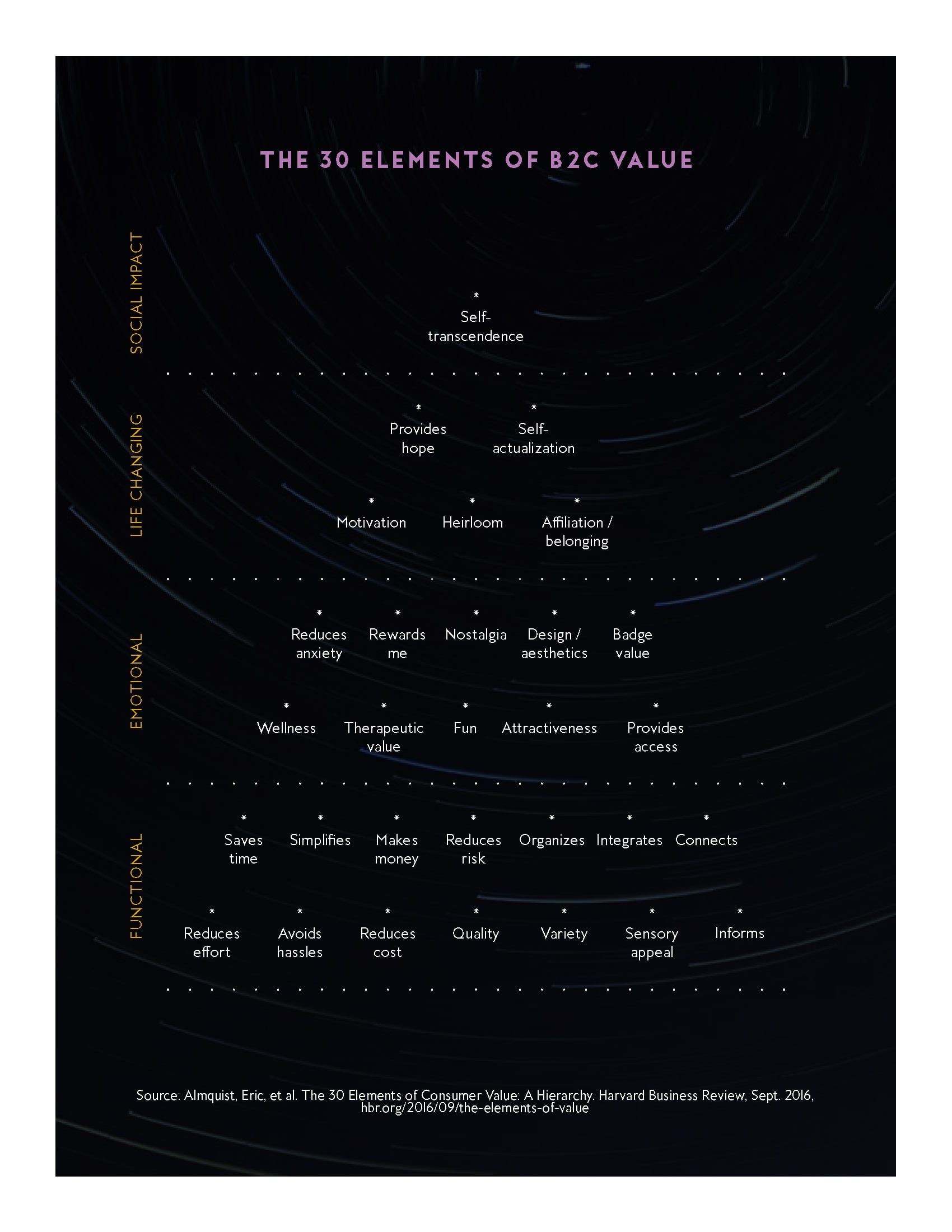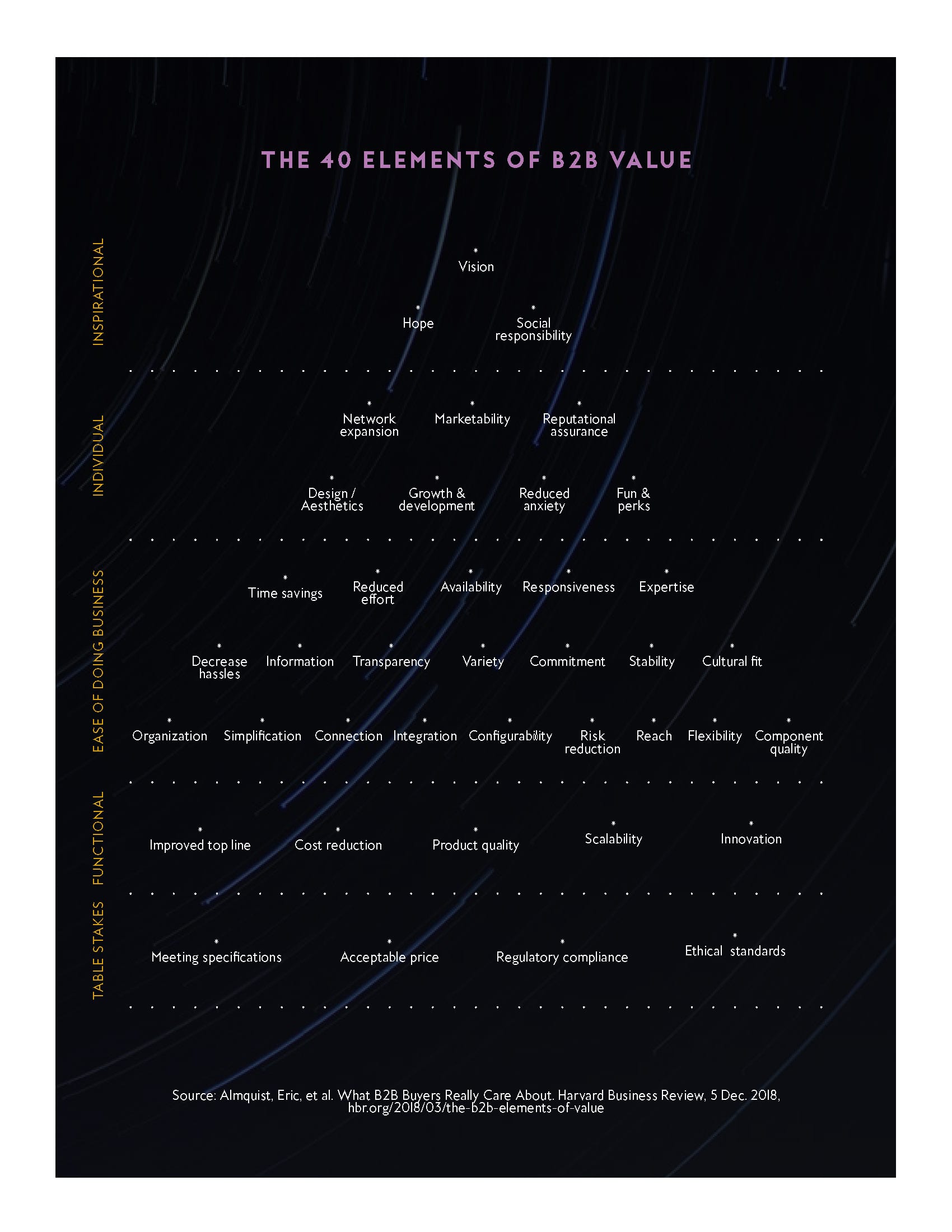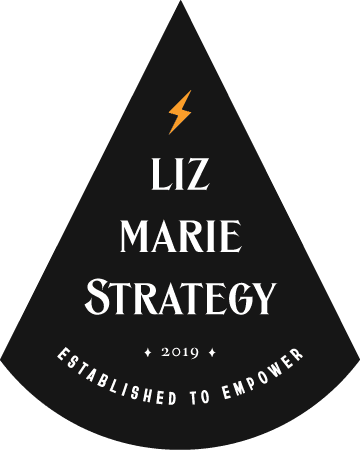If you want to build trust with your audience, give them something valuable. If you want to outcompete, you have to add more value (for the price) than your competition. According to researchers, there are 70 ways great businesses add more value for their customers.
What Is Value?
You may have heard that you need to create a value proposition for your company. A value proposition is a statement of the benefits delivered by the brand that provides value to the target customer. By default, all products and services are designed to deliver value in one or more ways. Value can be defined as all the benefits minus the costs.
Value created for customer = benefits – cost
This makes sense because the more benefits a customer gets, the more they are willing-to-pay. And the more you get for your money, the more “worth it”, or valuable, a purchase becomes. For a customer, the costs are pretty straightforward. They include things like actual price paid as well as time and effort to make the purchase. But the benefits are much broader. They can range from a plastic tray helping you organize your silverware to a yoga retreat fundamentally changing your worldview, and everything in between.
That may seem straightforward–even obvious. The idea of value is inherent in the decisions we make every single day. What isn’t quite so clear is how businesses create value. It seems like the possibilities are endless!
How do you create value?
Bain & Company and Harvard Business Review created two pyramids (below) that define the core elements of value for business-t0-consumer (B2C) and business-to-business (B2B) companies, rooted in psychologist Abraham Maslow’s hierarchy of needs. The elements at the bottom are more objective and those at the top are more subjective. Likewise, the potential emotional impact of the elements increase as you move up the pyramid.

For B2C businesses, these 30 elements of value fall into four categories: functional, emotional, life changing, and social impact. Here are some examples of how B2C brands offer these elements of value:
- With their slogan “15 minutes could save you 15% or more on car insurance”, GEICO reduces cost and their humorous commercials offer an element of fun
- Nike provides quality shoes and apparel, increased attractiveness because of their brand’s cool-factor, motivation through their “Just Do It” mindset and affiliation /belonging with their Nike Run Club.
- Google’s search engine saves time & reduces effort in finding information, informs, connects people, businesses and data and provides access to information.

For B2B businesses, the elements of value fall into five categories: table stakes, functional, ease of doing business, individual, and inspirational. Here ‘s an example:
Salesforce hits all of the tablestakes (the bare minimum), but also offers scalability, innovation, product quality and almost every element in the “Ease of Doing Business” category. As a result, their customers experience growth & development, reduced anxiety, network expansion, and maybe even a renewed vision for what their company can achieve. It’s no wonder Salesforce has been invaluable for millions of businesses.
With 70 Ways to Add Value, How Much Is Enough?
No company could add value in 70 ways. But that is not the goal. In fact, it doesn’t take as much as you might think to be successful.
Brands that add significant value in four or more ways grew 4x more than companies with only one element of value.
HARVARD BUSINESS REVIEW
Why Does Value Creation Matter to Your Brand?
Value creation is at the heart of branding and entrepreneurship. It is how brands differentiate from their competitors and appeal to customers. The impact of value creation cannot be understated. For middle market companies, for example:
Companies that can articulate the value they offer grow 2x as fast as companies that can’t.
National Center for Middle Market Growth
The more value you create for your customers, the more irreplaceable your product becomes. It’s how you beat your competition, build enduring customer loyalty, and grow your business to new heights.
How Can Your Brand Add More Value?
Your brand is probably already adding value in at least one of these ways. But how do you know? And where should you focus your value-add efforts?
Talk to Your Customers
All of the research you conduct to get to know your customer can also help you identify the ways in which you do add value now and identifies to add more in the future. By asking the right questions, you can discover which of the Elements of Value are most important to your customer and which you can fulfill for them.
Talk to Your Employees
Often, members of your team are full of ideas for how to make things better—especially those closest to your customers and your offering. Solicit their input on how you can be even more valuable in the future.
Strategize
Value creation doesn’t happen by accident. It is the result of a deliberate strategy and thoughtful execution. This process may involve going above and beyond your day-to-day business operations, or evolving your product or service itself.
Start with one of the values you wish to fulfill and begin to brainstorm. Be as creative as possible. No idea is too big. Focus on the ideas that align with your purpose, core values, customer experience and culture. Set a generous budget that accounts for the loyalty you are building with your core audience and explore the top ideas that fall within your budget. Begin to flesh out the details of your strategy. Gain input from key stakeholders or even use focus groups to test your ideas. When you’ve landed on the right approach, assemble your dream team and build your execution plan.
If you’re not adding any value, you’re not winning customers and you’re certainly not growing.
Common Value-Add Tactics
Content Creation
Content creation is a broad category that includes creating educational, informative, or entertaining articles, videos, tools, resources, etc. that benefit your customer. Some examples include robust training materials, documentation or courses, lifestyle blogs and magazines or YouTube channels with DIYs, tips & tricks or original content.
Thought Leadership
A type of content creation, thought leadership is a common B2B tactic that involves providing expert insights, research and analysis that help your customer.
Co-Creation
Co-creation brings your users into the creative process. This could range from enlisting influencers as guest authors on your company blog to launching a customizer tool that allows your customers to create a one-of-a-kind version of your product.
Giving Back
Many companies do some sort of charitable giving. By bringing your customers into the process, you can add value while doing good. For example, when someone purchases a pair of TOMS shoes, another pair is given to someone in need.
Customer Service
Incredible service, like Nordstrom or Four Seasons, can not only provide functional value, but emotional value as well.
Tribes & Fandoms
Your most loyal customers are already your best brand advocates. Nurture this community by building close relationships with them, providing exclusive perks and experiences, or giving them a platform to interact with each other.
Brand Messaging
Every one of the elements of value falls under the brand umbrella, but brand messaging is how you communicate the value you provide. It can be an incredibly powerful and simple way to add value. For example, the same airline ticket can be positioned as a low-cost, no frills fare or as the first step on a journey to self-discovery. The product hasn’t changed; just the message.
Looking at these 70 ways great businesses add more value, the sky is the limit for your businesses. Every part of your entire customer journey is a new opportunity to add value and set yourself apart from your competition. Get brainstorming today!
Need help building a value creation strategy? Or articulating your value proposition? Liz Marie has got you covered. Reach out to set up a quick and easy consultation today.
Sources:
Almquist, Eric, et al. The 30 Elements of Consumer Value: A Hierarchy. Harvard Business Review, Sept. 2016, hbr.org/2016/09/the-elements-of-value.
Almquist, Eric, et al. What B2B Buyers Really Care About. Harvard Business Review, 5 Dec. 2018, hbr.org/2018/03/the-b2b-elements-of-value.
Strategic Planning for Growth. National Center for Middle Market Growth, 2018, www.middlemarketcenter.org/middle-market-research-reports-full-research/strategic-planning-for-growth.
